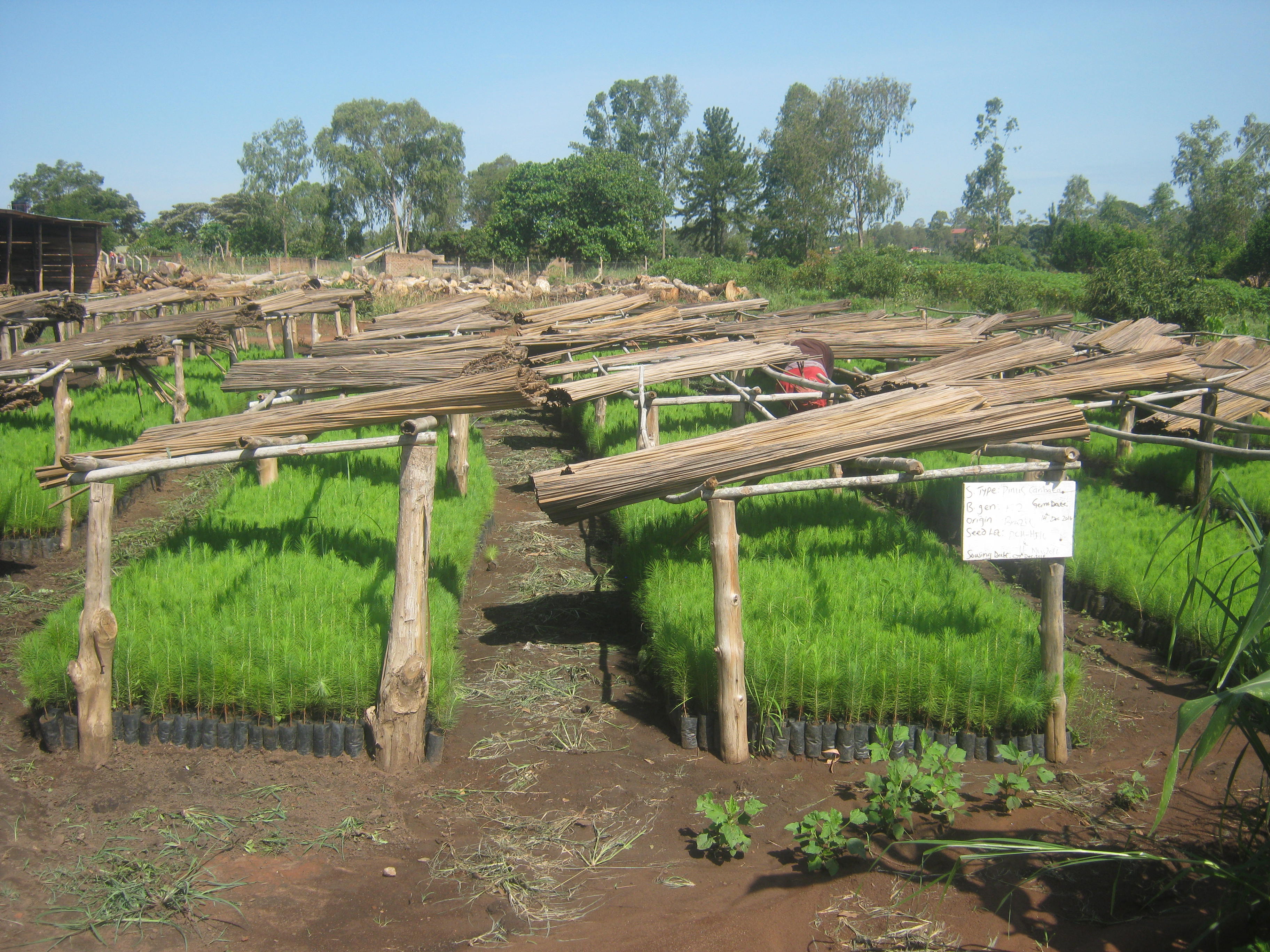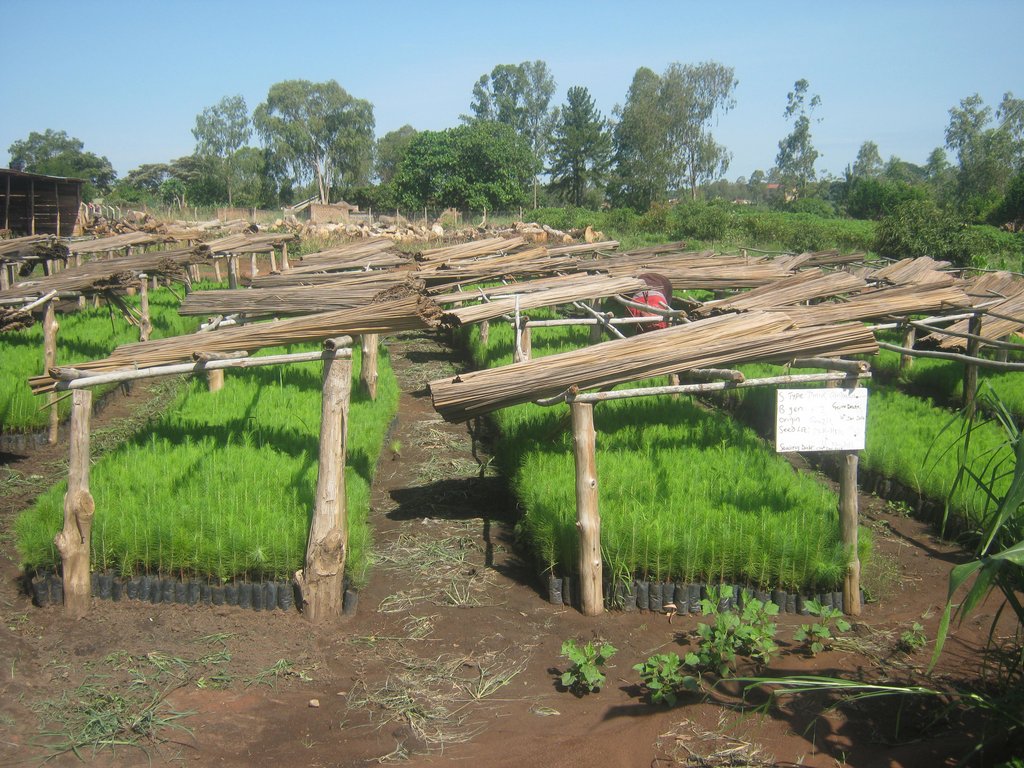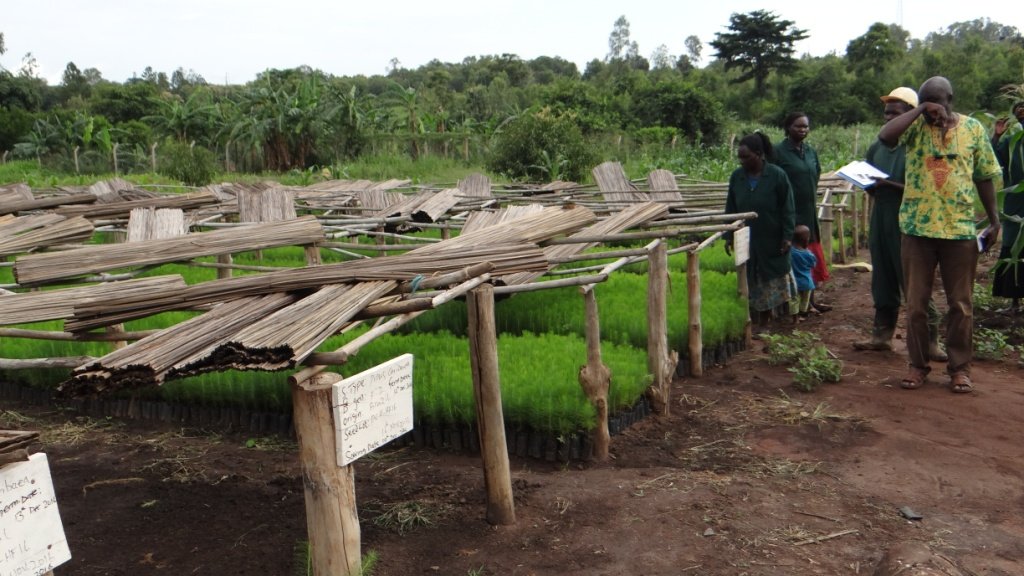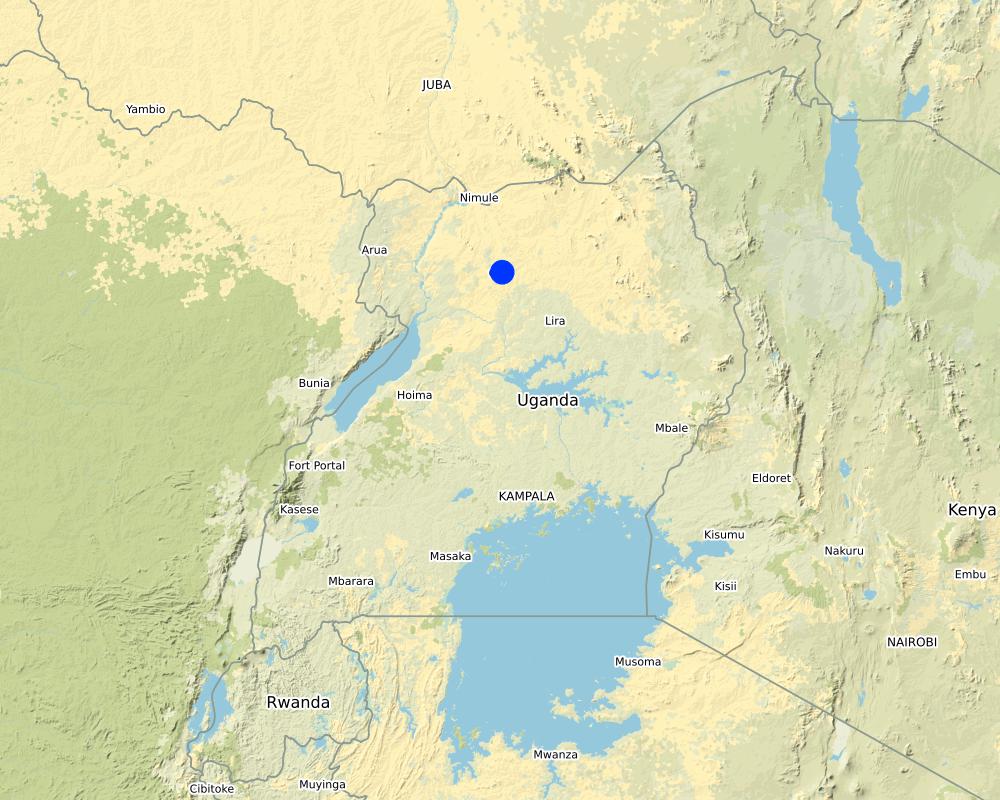Farmer Initiated Pine Tree Planting [Ouganda]
- Création :
- Mise à jour :
- Compilateur : betty adoch
- Rédacteur : Kamugisha Rick Nelson
- Examinateurs : John Stephen Tenywa, Udo Höggel
Tute pa lapur me pito yen
approaches_2898 - Ouganda
Voir les sections
Développer tout Réduire tout1. Informations générales
1.2 Coordonnées des personnes-ressources et des institutions impliquées dans l'évaluation et la documentation de l'Approche
Personne(s) ressource(s) clé(s)
exploitant des terres:
Langoya C. Dickson
0772605432 / 0712335432
jcforestryenterprise@gmail.com / langoyacd@yahoo.com
JC forestry enterprise limited
p.o.box 120
Ouganda
Nom du projet qui a facilité la documentation/ l'évaluation de l'Approche (si pertinent)
Scaling-up SLM practices by smallholder farmers (IFAD)Nom du ou des institutions qui ont facilité la documentation/ l'évaluation de l'Approche (si pertinent)
CDE Centre for Development and Environment (CDE Centre for Development and Environment) - Suisse1.3 Conditions relatives à l'utilisation par WOCAT des données documentées
Quand les données ont-elles été compilées (sur le terrain)?
26/05/2017
Le compilateur et la(les) personne(s) ressource(s) acceptent les conditions relatives à l'utilisation par WOCAT des données documentées:
Oui
2. Description de l'Approche de GDT
2.1 Courte description de l'Approche
Farmer owned initiated pine tree planting approach is an individual initiative promoted by a farmer with the aim of establishing modern tree nurseries for raising seedlings for other farmers and communal learning
2.2 Description détaillée de l'Approche
Description détaillée de l'Approche:
A farmer started the approach locally and later obtained training and approval to operate as certified tree nursery bed operator by the national forestry authority (NFA) to promote quality tree seedlings promotion. Northern Uganda normally experiences devastating fire outbreaks during dry seasons (November-March) which usually destroy vegetation covers. This leaves the land bare resulting in persistent soil erosion, low soil fertility, low production and low incomes. This is the reason to promote tree nurseries as an alternative source of income. The approach promotes environmental conservation through tree planting, triggers saw-log production, sustainable land utilization and increases household income from the sale of tree seedlings.
The nursery bed project was linked to a saw log production scheme Grant (SPGS) by the National Forestry Authority (NFA) who have supported and trained the farmer with grants/money for procuring the tree seeds from countries like Australia, Brazil and South Africa. This individual farmer together with SPGS and partners first developed guidelines (similar to a community’s constitution) informing on how to establish and manage tree nurseries plantations including marketing products for value addition. The guidelines highlight that:
(1) Prospective beneficiaries must be organized individuals operating a tree nursery bed
(2) The nursery bed should be certified resp. approved by the forestry authority (NFA)
(3) Nursery owners must train other community members on tree nursery bed establishment and tree planting
(4) Nursery owners must provide tree seedlings to other community members for purchase
(5) Beneficiaries must be in position to plant tree seedling in own fields which would, in turn, act as a demonstration site
(6) Beneficiaries should have willingness and ability to perform according to the guidelines (https://www.yumpu.com/en/document/view/37755510/spgs-tree-planting-guidelines for-Uganda-all-chapters-low).
Trees seedling procured by interested farmers are planted into the established seedbed at the onset of the rains under the supervision of the nursery bed owner. The community performs plantation planning meetings and training / exchange visits to empower other farmers to mobilize resources for environmental conservation. Up to now, participating farmers have been involved in raising over 350000 tree seedlings for timber and other tree species per year from 2007.
Benefits linked to this approach include the presence of the leadership committee supported by the guidelines/constitution to guide the farmers' activities, farmer-to-farmer learning, demonstration plots, and access to information and decision support on commercial forest plantation establishment.
The sale of products as well as environmental services has enabled the farmers’ community to extend its networks and partnerships beyond SPGS. Farmer communities also supply tree seedlings to churches, schools and other private clients. They do demonstrations and give advice to farmers so that their seedlings survive.
2.3 Photos de l'approche
2.4 Vidéos de l'Approche
Commentaire, brève description:
Pine seedlings ready for tranplanting
Date:
26/05/2017
Lieu:
Gulu District, Northern Uganda
Nom du vidéaste:
Betty Adoch
2.5 Pays/ région/ lieux où l'Approche a été appliquée
Pays:
Ouganda
Région/ Etat/ Province:
Northern Uganda.
Autres spécifications du lieu :
Gulu Municipality
Commentaires:
The GPS point is at the land user pine tree nursery site
Map
×2.6 Dates de début et de fin de l'Approche
Indiquez l'année de démarrage:
2007
2.7 Type d'Approche
- initiative/ innovation récente locale
2.8 Principaux objectifs de l'Approche
To promote environmental conservation through tree planting, improve saw-log production, sustainable land utilisation, and income
2.9 Conditions favorisant ou entravant la mise en œuvre de la(des) Technologie(s) appliquée(s) sous l'Approche
normes et valeurs sociales/ culturelles/ religieuses
- favorise
Involvement of local leaders like cultural and religious leaders on trees planting issues by the land user
disponibilité/ accès aux ressources et services financiers
- favorise
Saw log production grant scheme (SPGS) and the land user is financially stable
cadre institutionnel
- favorise
Support by SPGS grant and National Forestry Authority (NFA) for capacity building
- entrave
Poor enforcement of bylaws on free grazing
collaboration/ coordination des acteurs
- favorise
Presence of memorandum of understanding and presence of other tree growers
- entrave
Short term period of collaboration
cadre juridique (régime foncier, droits d'utilisation des terres et de l'eau)
- favorise
Land user has full right over his private land
- entrave
Land wrangles by neighbours
cadre politique
- favorise
Formulated using bottom-up approach
- entrave
Poor enforcement of laws on tree protections
gouvernance foncière (prise de décisions, mise en œuvre et application des décisions)
- favorise
presence of bylaws, guidelines
- entrave
Poor enforcement
connaissances sur la GDT, accès aux supports techniques
- favorise
Have had training on SLM
- entrave
Low adoption outside SPGS supported farmers
marchés (pour acheter les intrants, vendre les produits) et prix
- favorise
Increased demand for tree products (timber)
- entrave
Sale of raw products at low price
charge de travail, disponibilité de la main-d'œuvre
- favorise
Trained by SPGS and other collaborators
- entrave
Low number of hired labour not trained by SPGS
3. Participation et rôles des parties prenantes impliquées dans l'Approche
3.1 Parties prenantes impliquées dans l'Approche et rôles
- exploitants locaux des terres / communautés locales
Local communities
Implementation and use of approach
- Spécialistes de la GDT/ conseillers agricoles
Small Production Grants Scheme (SPGS),National Forestry Authority (NFA),Uganda Tree Grower Association
Research
- chercheurs
National Forestry Authority students
Field work and data collection for
publication
- enseignants/ élèves/ étudiants
University students, primary and secondary
teachers.
Field work and support trainings
- ONG
Food and Agriculture Organisation (FAO),
Uganda Timber Growers Association (UTGA)
Support trainings
- gouvernement local
Councillors and Forestry officers
Linkage to NGO's, training's and
administrative guidance as well as security
- gouvernement national (planificateurs, décideurs)
National Forestry Authority (NFA)
Planning and Commissioning
- organisation internationale
Food Agriculture Organisation (FAO)
Funding
3.2 Participation des exploitants locaux des terres/ communautés locales aux différentes phases de l'Approche
| Participation des exploitants locaux des terres/ communautés locales | Spécifiez qui était impliqué et décrivez les activités | |
|---|---|---|
| initiation/ motivation | auto-mobilisation | The land users mobilise resources for the establishment of the tree nursery bed |
| planification | auto-mobilisation | The land users are active in the planning process of the nursery bed activities |
| mise en œuvre | interactive | The land users and SPGS |
| suivi/ évaluation | interactive | The land users and SPGS |
3.4 Prises de décision pour la sélection de la Technologie/ des Technologies
Indiquez qui a décidé de la sélection de la Technologie/ des Technologies à mettre en œuvre:
- les exploitants des terres seuls (auto-initiative)
Spécifiez sur quelle base ont été prises les décisions:
- expériences et opinions personnelles (non documentées)
4. Soutien technique, renforcement des capacités et gestion des connaissances
4.1 Renforcement des capacités/ formation
Une formation a-t-elle été dispensée aux exploitants des terres/ autres parties prenantes?
Oui
Spécifiez qui a été formé:
- exploitants des terres
Formats de la formation:
- sur le tas
- entre agriculteurs (d'exploitants à exploitants)
- zones de démonstration
- réunions publiques
- cours
4.2 Service de conseils
Les exploitants des terres ont-ils accès à un service de conseils?
Oui
Spécifiez si le service de conseils est fourni:
- dans les champs des exploitants?
4.3 Renforcement des institutions (développement organisationnel)
Des institutions ont elles été mises en place ou renforcées par le biais de l'Approche?
- oui, beaucoup
Spécifiez à quel(s) niveau(x), ces institutions ont été renforcées ou mises en place:
- local
- régional
- national
- international
Décrivez l'institution, ses rôles et responsabilités, ses membres, etc.
European journalists makes follow up on the project progress basing on the grant given.
Précisez le type de soutien:
- financier
- renforcement des capacités/ formation
- équipement
4.4 Suivi et évaluation
Le suivi et l'évaluation font ils partie de l'Approche? :
Oui
Si oui, ce document est-il destiné à être utilisé pour le suivi et l'évaluation?
Oui
4.5 Recherche
La recherche a-t-elle fait partie intégrante de l’Approche?
Oui
Spécifiez les thèmes:
- sociologie
- économie/ marketing
- technologie
Donnez plus de détails et indiquez qui a mené ces recherches:
SPGS and university students
5. Financement et soutien matériel externe
5.1 Budget annuel de la composante GDT de l'Approche
Si le budget annuel précis n'est pas connu, indiquez une fourchette:
- < 2 000
5.2 Soutiens financiers/ matériels fournis aux exploitants des terres
Les exploitants des terres ont-ils reçu un soutien financier/ matériel pour la mise en œuvre de la Technologie/ des Technologies?
Oui
Si oui, spécifiez le(s) type(s) de soutien, les conditions et les fournisseurs:
FAO, SPGS
5.4 Crédits
Des crédits ont-ils été alloués à travers l'Approche pour les activités de GDT?
Oui
Spécifiez les conditions (taux d'intérêts, remboursements, etc.):
Interest free loan
Spécifiez les fournisseurs du crédit:
SPGS
Spécifiez les destinataires du crédit:
The land user
5.5 Autres incitations ou instruments
D'autres incitations ou instruments ont-ils été utilisés pour promouvoir la mise en œuvre des Technologies de GDT?
Oui
Si oui, spécifiez:
Formulation and implementation of bylaws, Trainings, Exchange visits.
6. Analyses d'impact et conclusions
6.1 Impacts de l'Approche
Est-ce que l'Approche a autonomisé les exploitants locaux des terres, amélioré la participation des parties prenantes?
- Non
- Oui, un peu
- Oui, modérément
- Oui, beaucoup
Farmers are able to utilise their land through tree planting
Est-ce que l'Approche a permis la prise de décisions fondées sur des données probantes?
- Non
- Oui, un peu
- Oui, modérément
- Oui, beaucoup
Decision on when to plant the tree nurseries
Est-ce que l'Approche a aidé les exploitants des terres à mettre en œuvre et entretenir les Technologies de GDT?
- Non
- Oui, un peu
- Oui, modérément
- Oui, beaucoup
Incentives based (in form of trainings and seedlings)
Est-ce que l'Approche a amélioré la coordination et la mise en œuvre de la GDT selon un bon rapport coût-efficacité?
- Non
- Oui, un peu
- Oui, modérément
- Oui, beaucoup
Coordinated by the land user. Strengthened working as a group (hired labour).
Est-ce que l'Approche a mobilisé/ amélioré l'accès aux ressources financières pour la mise en œuvre de la GDT?
- Non
- Oui, un peu
- Oui, modérément
- Oui, beaucoup
Land user can easily borrow interest free loan from the bank
Est-ce que l'Approche a amélioré les connaissances et les capacités des exploitants des terres pour mettre en œuvre la GDT?
- Non
- Oui, un peu
- Oui, modérément
- Oui, beaucoup
Access to technologies (seedlings), knowledge on planting, spacing and pruning and thinning
Est-ce que l'Approche a amélioré les connaissances et les capacités des autres parties prenantes?
- Non
- Oui, un peu
- Oui, modérément
- Oui, beaucoup
Especially farmers involved and partners
Est-ce que l'Approche a construit/ renforcé les institutions, la collaboration entre parties prenantes?
- Non
- Oui, un peu
- Oui, modérément
- Oui, beaucoup
Different partners participated and contributed to implementing the approach. Community bylaws and functioning committee.
Est-ce que l'Approche a atténué les conflits?
- Non
- Oui, un peu
- Oui, modérément
- Oui, beaucoup
Conflicts between the land user and livestock owners (Free grazing on trees). Conflicts resolved using bylaws.
Est-ce que l'Approche a autonomisé les groupes socialement et économiquement défavorisés?
- Non
- Oui, un peu
- Oui, modérément
- Oui, beaucoup
Focus was not on well off women farmers but those who had interest in tree planting as an individual or group
Est-ce que l'Approche a amélioré l'égalité entre hommes et femmes et autonomisé les femmes et les filles?
- Non
- Oui, un peu
- Oui, modérément
- Oui, beaucoup
Women are the majority who buy seedlings, eldery and youths
Est-ce que l'Approche a encouragé les jeunes/ la prochaine génération d'exploitants des terres à s'engager dans la GDT?
- Non
- Oui, un peu
- Oui, modérément
- Oui, beaucoup
Those who belong to the households from which members came from to buy tree seedlings
Est-ce que l'Approche a amélioré les questions foncières et des droits d'utilisation qui entravent la mise en œuvre des Technologies?
- Non
- Oui, un peu
- Oui, modérément
- Oui, beaucoup
Focused more on training and production
Est-ce que l'Approche a conduit à améliorer la sécurité alimentaire et/ou la nutrition?
- Non
- Oui, un peu
- Oui, modérément
- Oui, beaucoup
Income from the sale of tree products was used for buying food
Est-ce que l'Approche a amélioré l'accès aux marchés?
- Non
- Oui, un peu
- Oui, modérément
- Oui, beaucoup
Good quality tree products. Linkage done by SPGS.
Est-ce que l'Approche a conduit à améliorer l'accès à l'eau et l'assainissement?
- Non
- Oui, un peu
- Oui, modérément
- Oui, beaucoup
Nursery bed based near the a stream for easy watering
Est-ce que l'Approche a conduit à l'utilisation/ sources d'énergie plus durables?
- Non
- Oui, un peu
- Oui, modérément
- Oui, beaucoup
Source of fuel wood
Est-ce que l'Approche a amélioré la capacité des exploitants des terres à s'adapter aux changements/ extrêmes climatiques et a atténué les catastrophes liées au climat?
- Non
- Oui, un peu
- Oui, modérément
- Oui, beaucoup
Carbon sequestration
Est-ce que l'Approche a conduit à des emplois, des opportunités de revenus?
- Non
- Oui, un peu
- Oui, modérément
- Oui, beaucoup
Farm workers in the tree nursery bed and plantations
6.2 Principale motivation des exploitants des terres pour mettre en œuvre la GDT
- augmenter la production
- augmenter la rentabilité/ bénéfice, rapport coûts-bénéfices
- réduire la dégradation des terres
- réduire les risques de catastrophe
- réduire la charge de travail
- règles et règlements (amendes)/ application
- prestige, pression sociale/ cohésion sociale
- coutumes et croyances, morale
- améliorer les connaissances et compétences en GDT
- améliorer l'esthétique
- atténuer les conflits
6.3 Durabilité des activités de l'Approche
Les exploitants des terres peuvent-ils poursuivre ce qui a été mis en œuvre par le biais de l'Approche (sans soutien extérieur)?
- oui
Si oui, décrivez de quelle manière:
The land user is involved in selling tree seedlings, trees and the income obtained is used to manage the nursery bed and forest activities like fireline, weeding etc. The presence of an organised leadership. With better management skills to manage, the land user will keep working very closely with other groups .
6.4 Points forts/ avantages de l'Approche
| Points forts/ avantages/ possibilités du point de vue de l'exploitant des terres |
|---|
| Maximum productivity per unit area |
| High income |
| Carbon sink |
| Points forts/ avantages/ possibilités du point de vue du compilateur ou d'une autre personne ressource clé |
|---|
| Modify climate |
| Mitigate land conflict |
| Social interactions |
6.5 Faiblesses/ inconvénients de l'Approche et moyens de les surmonter
| Faiblesses/ inconvénients/ risques du point de vue de l’exploitant des terres | Comment peuvent-ils être surmontés? |
|---|---|
| High cost of planting materials | acquiring own seedling source |
| High costs of inputs and chemicals | purchase affordable once |
| Climate variability | irrigations |
| Faiblesses/ inconvénients/ risques du point de vue du compilateur ou d'une autre personne ressource clé | Comment peuvent-ils être surmontés? |
|---|---|
| The approach usually starts by an individual farmer | He needs to form an organisation where they can work as a group for improved efficiency |
7. Références et liens
7.1 Méthodes/ sources d'information
- visites de terrain, enquêtes sur le terrain
01
- interviews/entretiens avec les exploitants des terres
04
Liens et modules
Développer tout Réduire toutLiens
Aucun lien
Modules
Aucun module trouvé





